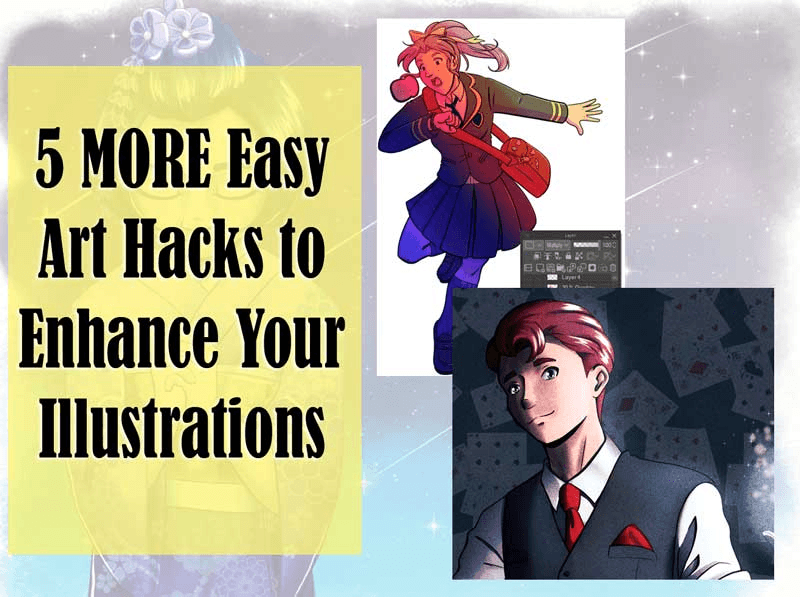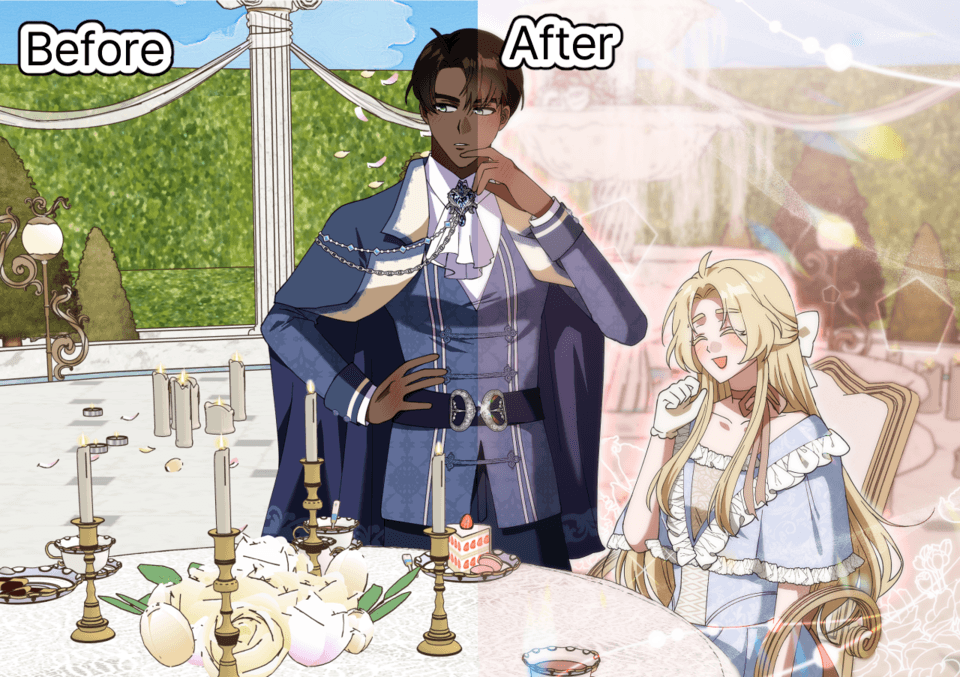Give your backgrounds a nostalgic feel
Intro
In this article I will show you how to add a sense of nostalgia to your drawings. When we look at backgrounds or landscapes that give us this feeling, we can ask ourselves what are the elements that evoke this feeling. It feels like you want to return to that place, even though you have never been there before, and that sense of calm and peace is almost like a dream from the past.
So, we want to create a setting that is a frame from the past that reminds us of a quiet moment that we want to return to.
The relativity of colours
The first method I would like to show you is based on choosing the right color palette. In fact, desaturated colors can create a sense of nostalgia.
The first color we need to choose is the color of the sky, because it will affect all the other colors in our background. Remember that we are basically creating a scene that has a dreamy feel to it, almost frozen in the past.
In general, I prefer to set this type of landscape in two phases of the day, twilight and dawn. In these phases, the sky has warm and cold tones.
Grey is the way
So, let's say we choose a warm yellow that reminds us of the color of twilight.
Double-click on a color in the tools menu and the color setting window will appear. I recommend that you select color wheel 1 and then click on the triangle to select your color:
As you can see in the image above, it is important to avoid vivid tones, which are on the right-hand side of the triangle, and instead choose a desaturated color, which means a more greyish set of colors.
Once we have chosen the color of the sky, how can we determine all the other colors? Let's take another look at the color wheel:
Move the little slider on the color wheel and stop where you see the green marks in the picture above. Say you want a warm color, move the slider towards red and stop where the marker is, and if you want a cold color, move the slider in the opposite direction towards green and stop where the other marker is.
As you can see, you are limited to a relatively small range, but I promise it will work like magic, as you will see in a moment. Of course, once you have moved that little slider, you can choose a color in the triangle, always avoiding bright colors and preferring more greyish ones.
You can use this method starting from the color you prefer, in this case I choose a yellow tone, if you choose another color the principles are the same, you should limit the range of all the other colors within that tone, moving on the wheel just a little towards the warm or cold tones without going to the next tone.
Look at the next picture:
I draw this background using this method, as you can see, even if you pick an area of the drawing that looks like some kind of green, it is still in the yellow zone. All the colors in these drawings are in the yellow zone, even the ones you think are cold tones.
I will show you later in this article how to add light to enhance the nostalgic feeling.
By the way, if you want to learn how to get that wonderful reflection on the lake, check out my article "Understanding reflections to improve your illustrations".
Turning colours afterwards
We have seen how to play with colors to create that nostalgic feeling, but what if you already have a background painted with many different colors and you want to quickly use the technique I have shown you, without having to repaint it? It is very simple, create a new layer on top and change the blend mode to "Hue". Pick a warm yellow color and use the fill tool (G) to fill the whole layer, lowering the opacity to about 70%.
Now you can use the Eyedropper tool to check that each color is in the range you want, if not, just adjust the opacity again until you get the result you want.
Key elements of nostalgia
When it comes to nostalgic backgrounds, there are always a few key elements that you need to add to help you evoke that feeling in your audience.
The power of clouds
An important element that allows us to capture the imagination of the viewer is clouds. If you think about it, it is a natural instinctive act to look at the sky and start dreaming by looking at all the different shapes that clouds have. They also make the sky we draw more interesting and avoid a flat result.
So, we want to draw fluffy, calm clouds. Let's see the process I use, step by step:
I only use two types of standard brushes to draw clouds, the "Dense watercolor" and the "Smooth watercolor" brushes.
First I draw simple circular shapes with the Dense watercolor brush, then I use the Smooth watercolor brush to soften the edges until I get the result I want. It is quite simple. Once you are happy with your clouds you can add a new layer on top in Hard Light blend mode, right-click and select Layer Settings, Clip to Layer Below. Now select a warm color and use the Smooth Watercolor brush to paint over the “soft” areas, not the denser ones you did with the Dense watercolor. You will get a result like this:
More sky less land
We can enhance the contemplative effect by playing with the proportions of our background. In fact, if we give our background more vertical space, so that we see more sky than land, we give our mind more space to think and imagine.
As I said at the beginning, I like twilight because it allows you to play with warm and cold colors. You can also give a blue tone to things that are far away on the horizon line, like mountains. This is because the blue of the sky affects everything.
Create a story with one element
Now that we have our setting, we need to add the finishing touch. If you think about it, the setting itself is not enough to create that sense of nostalgia, so we need to introduce an element that allows the viewer's mind to imagine a story by itself just by looking at that element.
To do that, one element is enough, just one element that acts like a sparkle for our mind to dream about the story behind that background. This is very important. It could be a bicycle or an ancient statue, or in my case a beautiful Italian villa, a mysterious stone and an ancient temple. It is up to your imagination to place the element that gives meaning to the whole scene.
Light and shadows
We have drawn our background and we already have that feeling of memories from the past, but we want to enhance it by playing with light and shadow. Shadows are important in this kind of setting because they make us feel like we are under something big that protects us, like trees.
Improve parts exposed to light
First, let's see how we can make parts of the drawing that are exposed to light stand out.
Create a new layer on top of the layer you want to affect, right-click on it and select Layer Settings, Clip to Layer Below. Now change the blend mode to Hard Light or any other type of blend mode that adds light. Select a brush tool, I prefer the Smooth Watercolor brush, and paint the light.
Always pay attention to where the light is coming from and paint accordingly, remembering that just a few strokes are enough, don't overdraw.
Komorebi
This Japanese term is very specific and refers to the light that passes through the leaves of tree branches and casts a shadow on the ground. Everyone knows the feeling of calm that Komorebi gives, it is almost magical. Let's see how we can reproduce this effect:
You can create this effect in two stages. First you need to create a new layer, set it to multiply and use the marker tool to paint over the area where the entire shadow will be. Once you have done this, reduce the opacity of the layer.
In the second stage, you can use a free brush, which will allow you to paint leaves, but since we want to erase parts of the shadow, we will press C on the keyboard, this will turn the brush into an eraser, which will keep all its characteristics. At this point, use a larger size of the brush to paint the areas that are closer and a smaller size to paint the areas that are further away to create a sense of perspective.
Use the normal eraser tool, both hard and soft, to soften the edges of the shadow.
For the final touch, go to Filters, Blur, Gaussian blur and just a little bit of blur. Now go to Edit, Transform, Free Transform and stretch the shadow a little to create the effect of distortion because the shadow is being projected onto the ground from a certain height.
Komorebi with glow
One last thing, if you want to add that intense glow that I really like, you can find the asset by searching for "komorebi" in clip studio assets. Repeat the same steps you took to create the Komorebi, but this time add another layer on top of the multiply layer with the shadow. Set the new layer to Hard Light or any other light blend mode and paint on it. There are several brushes in the asset that allow you to create this glow effect, remember that you need to choose the main color, which in this case will be white, and the secondary color, in this case I chose a vibrant green, which will give the glow around the edges.
I suggest you use the Clip Studio Assets, they are very useful and easy to use. Click on the link below to go to the assets page and search for “komorebi” or “trees” or whatever you want. Remember to press the Popular button to see the most popular asset.
Outro
We have seen how choosing the right color palette, or introducing the few elements in your drawings, or playing with the effect of light and shadow, can allow us to create an environment that evokes nostalgia in our viewers. You can combine these methods to create amazing backgrounds, these tips work no matter if the background is set in a natural environment or any other. Thank you for reading and see you in the next article, bye bye!





















Comment